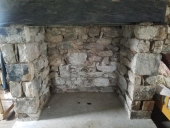Jeff Thorpe wrote:I would like to build a RMH in my home and store the heat in water, and then connect to my baseboard system for whole house heating - has anyone done anything like this?
I am on the same kind of project, researching, and experimenting with the idea. I have built some crude wood fired boilers, some rocket stoves, and am currently building a large rocket stove intended to heat the house as a boiler. Have done some interesting firing experiments with cordwood as well as wood chips, quite successful but so far the stove is not hooked up to anything, just running out in the driveway.
{and yes, I am competent to build a wood fired boiler that won't explode or burn down my house. An important consideration}
Buffer tank sizing is a little complicated, but not overwhelming. I went through that in this
post on Hearth.com, read it and then come back here. The short answer is you are sizing the buffer tank to absorb the full output of one firing of the wood stove (if it is batch fired) and then sizing the system so that so-many-firings of the wood boiler will provide so-many-btus daily for a house heating load. I ended up with about 450 gallons needed to allow 2 firings per day. That's typical.
The question I am pondering right now is how to make a good heat exchanger to absorb heat out of the flue gas from a big rocket stove. There are about three good ways to go:
Coils of copper pipe (water tube)
Steel or stainless steel tubes inside some sort of flue box (water tube)
steel or stainless steel tubes inside some kind of water tank (fire tube)
Copper melts at low temperatures and corrodes easily, but is a great heat transfer medium and is easy to work with. Copper does not get along with flue gases or dissimilar metals. I am imagining using copper coils inside a layer of castable refractory cement (to separate it from the corrosive flue gasses and provide a heat transfer medium) adjacent to a flue. Haven't thought this all the way through.
Water tubes inside some kind of flue box have been done by
several hackers. There is a company that
sells stainless steel tubes for this purpose. Simple but expensive answer would be to buy 3 of their coils, install them in a 55 gallon barrel, and plop that on top of my rocket stove. The rest is plumbing.
A fire tube heat exchanger is also interesting. If one was a good welder one could weld tubes into a tank watertight, fill it with water, add a circulating pump (and safety controls and temp/pressure relief!) and pump hot water to your buffer tank. A 30 gallon barrel, with fire tubes inside, inside a 55 gallon barrel, arranged so the flue gases went through the fire tube pipes, might make a pretty good heat exchanger.
All these heat exchangers are heavy and require independant structural support. Fire tube is the heaviest.
Water treatment is an important consideration often missed by us hackers. All of this stuff (flue gases, water) is corrosive.
These guys sell all the chemicals and test kits you'll need to keep your pipes from rusting out in a year.
Open vs. Closed system? Open systems seem simpler at first, have less (but not zero) potential for a steam explosion. But they evaporate water, requiring makeup water, they introduce oxygen, which accelerates corrosion and thus use more chemicals. Pumps in open systems may have higher head requirements and may need to be self-priming. Closed systems solve about half these problems and introduce several more - need expansion tanks, perhaps more overtemp/overpressure relief valves, and so on.
What I am finding out is, the hydronic end of this will be more expensive than the wood stove itself. Pumps are $200 a pop, copper or stainless is outgrageous, aquastats and overtemp/overpressure valves are needed, expansion tanks aren't cheap either.










































 )
)



























